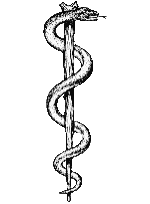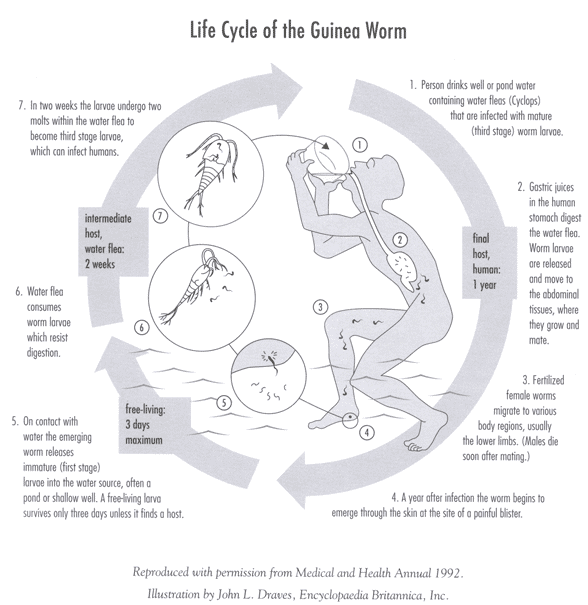Guinea Worm Eradication Program

Guinea worm is more than 3,000 years old. It has been found in calcified Egyptian mummies. Many believe the symbol of medicine often interpreted as a snake wrapped around a stick, may be a Guinea worm.
Often known as the "fiery serpent," Guinea worm disease (dracunculiasis) has existed since ancient times, but an international coalition led by The Carter Center is now close to eradicating it. With its access to world leaders, the Center is mobilizing government officials and garnering support for the Guinea worm disease eradication effort, while working at the village level to empower and educate communities to take simple measures to prevent the disease from recurring.
Guinea worm disease is contracted when a person drinks stagnant water that is contaminated with microscopic water fleas carrying infective larvae. Inside a person's body, the larvae grow for approximately one year, becoming thin thread-like worms, up to one meter long. These worms create agonizingly painful blisters in the skin, through which they slowly exit the body. People with emerging worms must not bathe or step in sources of drinking water, because a worm will release hundreds of thousands of eggs, or larvae, into the water. Water fleas then eat the larvae, and people who drink unfiltered water from the pond become infected -- continuing the life cycle of the parasite.

Prevalence of Guinea Worm
When The Carter Center began leading the campaign to eradicate Guinea worm in 1986, there were an estimated 3.5 million cases of the disease in 20 countries in Africa and Asia. Today, there are fewer than 5,000 cases in six African countries—Sudan, Ghana, Mali, Ethiopia, Nigeria, and Niger.
Impact on Communities
The presence of Guinea worm disease is an indicator of extreme poverty, including the absence of safe drinking water, in a community. Entire communities suffer, not just the individuals afflicted with Guinea worm disease. Victims are totally incapacitated as a worm emerges from their body. Children cannot attend school. Farmers cannot farm.
Read some stories about success against Guinea worm
- Dr. Ruiz-Tiben on the Guinea Worm Eradication Program
- Chief Tahanaa on progress in the Northern Region of Ghana
- Dr. Sankara Works Miracles in Burkina Faso
Treatment for Guinea Worm Disease
There is no vaccine or medicine to treat or prevent Guinea worm disease. Infected people won't even realize they have it until a year after drinking contaminated water, when they will develop blisters as the worm begins to emerge. Once that happens, a local health worker or the patient will wrap the live worm around a piece of gauze, extracting it from the body little by little. The long, painful process often takes up to one month.
Preventive Measures
Health education and low-technology measures to promote behavioral change are used to prevent Guinea worm disease. The most effective way to prevent it is to filter the tiny water fleas out of drinking water. The Carter Center provides families with fine-mesh filter cloths that fit over clay pots used to hold water. Some people, especially nomadic groups, receive pipe filters, which are small straw-like personal filters that can be worn around the neck. These simple but revolutionary devices enable people to drink water safely no matter where they are. Other important interventions include treating ponds with a safe chemical larvicide called ABATE©, donated by BASF, and constructing boreholes or deep wells.
Banishing a Disease Forever
Humans are a Guinea worm's only host, so spread of the disease can be controlled by identifying all cases and modifying human behavior to prevent it from recurring. Once all human cases are eliminated, the disease will be eradicated. Today, cases of Guinea worm disease are down more than 99% since 1986, making it poised to be the next disease after smallpox to be eradicated.
It will be the first parasitic disease to be eradicated and the first disease to be eradicated without vaccines or medicines. The only other "active" eradication campaign is against polio. In addition to Guinea worm, the Carter Center's International Task Force for Disease Eradication has identified only six other diseases as potentially eradicable. Read more about the International Task Force for Disease Eradication.
Back to Carter Center main page
Adapted with permission from the Carter Center website,www.cartercenter.org, February 2009.

- Emily Staub
- Associate Director, Public Information
- Press Liason to the Health Programs
- Phone: 404-420-5100
- Email: carterweb@emory.edu
- www.cartercenter.org/health/index.html